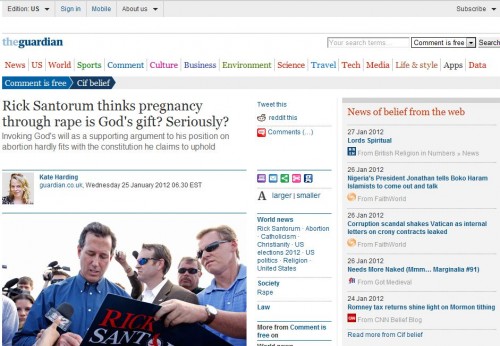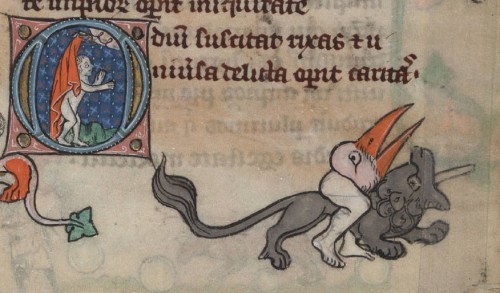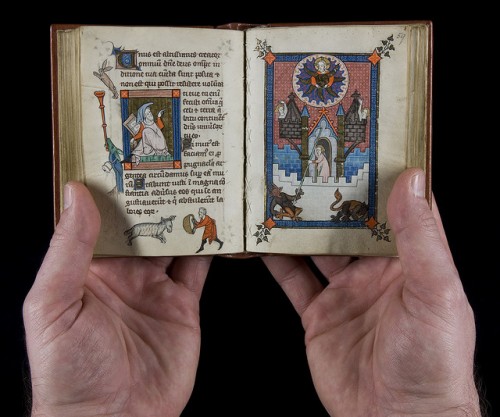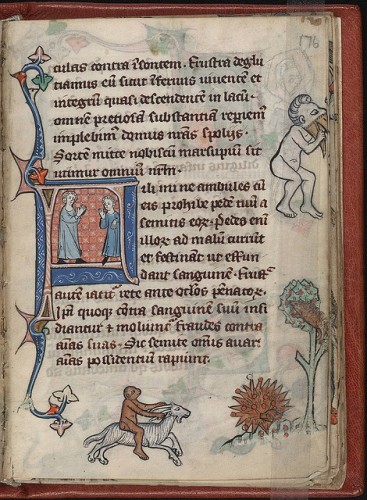While I fuss over this week’s Thesis Thursday ((My increasingly poorly named recurring feature. Don’t worry. I’ll backdate it like a pro.)) installment, why not drop on by the Guardian.co.uk? I usually don’t recommend doing so, but this morning they seem so much more reasonable and credible to me. I wonder why…

Oh yeah, I know why. Computer: enhance and zoom.

It’s because my last marginalia post is currently linked there under “news of belief from the web”.
I suppose naked dudes frolicking ((Hardly an adequate word to describe what they’re up to, but I have to save all the words I can for Uther.)) in the margins of a nun’s prayer book is technically in the realm of “belief”–as in, I believe what those naked dudes are doing in that prayer book is kind of freaky. Not that their being there is freaky, exactly, just the whole jousting backwards on goats thing. And the freakier stuff I didn’t include, like these scandalous humpers:

Anyway, I’m sure you’re all glad to know that this blog you read now qualifies as one of the Guardian’s “plurality of voices,” and that fourteenth-century nekkid dudes are within the pull of their “centre of gravity as a progressive, liberal, left-leaning newspaper”.
But before I go, I will take this as a chance to clarify one or two things about the naked dude manuscript that I worry didn’t come across in my last post. One is the manuscript’s size. Though the Beinecke helpfully makes enormous resolution images of the book available, the actual manuscript is pocket sized, as you can see in this image: ((Don’t ask me why the clothed dude is fighting a goat with a basket.† The illuminator likes weird goat humor almost as much as naked dude humor.
† And how the elephant got in my… er, how the goat got a basket, I’ll never know.))

The other thing is that there were, as with the Smithfield Decretals, several rounds of illumination performed on the Rothschild Canticles. Indeed, that’s why I titled the post “Needs More Naked”. The book’s owner was unsatisfied with the amount of freaky naked dudes the original artist put in ((Hardly any, as it turns out.)) and went back to have at least two other artists add more. Incidentally, this is why some of those images were cropped off on the sides. Because they weren’t in the original plan for the manuscript, they were too close to the edges of the page. When the pages had to be trimmed back because of fraying and damage, they got cut out. ((Also, because they’re not part of the plan, they violate many of the rules I’ve asserted exist in the world of the marginal page, particularly the marginal artist’s reluctance to put images in the open space without having them hang onto something or drawing some ground under their feet. The first illuminator is scrupulous about this, the later ones don’t seem to know that’s how it works. An interesting subject for a future post, I hope.)) Professional manuscript scriptoria usually were very careful to leave enough “margin for error” in the margins, knowing the precious books were meant to be kept for a long time, passed down over generations even, and would thus need such repair eventually.
Because of this manuscript’s unfortunately short-sighted patroness, I probably will never be able to put together a post about the weird dudes with beaks sewn to their faces, as most of them got cut in half. Here’s one of the more complete ones, in the upper right margin:

But thankfully, as you can see, that keen little goat-riding monkey is still intact, ((It’s nice to know that when you write in as old a language as English you can still write sentences (and clauses) that no one has ever written. Surely no one has before now had the occasion to express in prose their happiness that a goat-riding monkey remains safe. ††
†† Because of how dangerous goat-riding is. These monkeys today don’t even wear helmets, always drag racing the other monkeys on goats to impress the lady monkeys. So many monkey lives tragically cut short.)) and the strange (but awesomely so) image of hedgehogs using their quills to collect apples is almost complete. There will certainly be fodder for many a post to come here in this nun’s pocket devotional book, don’t you worry, even if we must bid adieu to our beaked freak friends. But for now, back to editing. Uther calls.